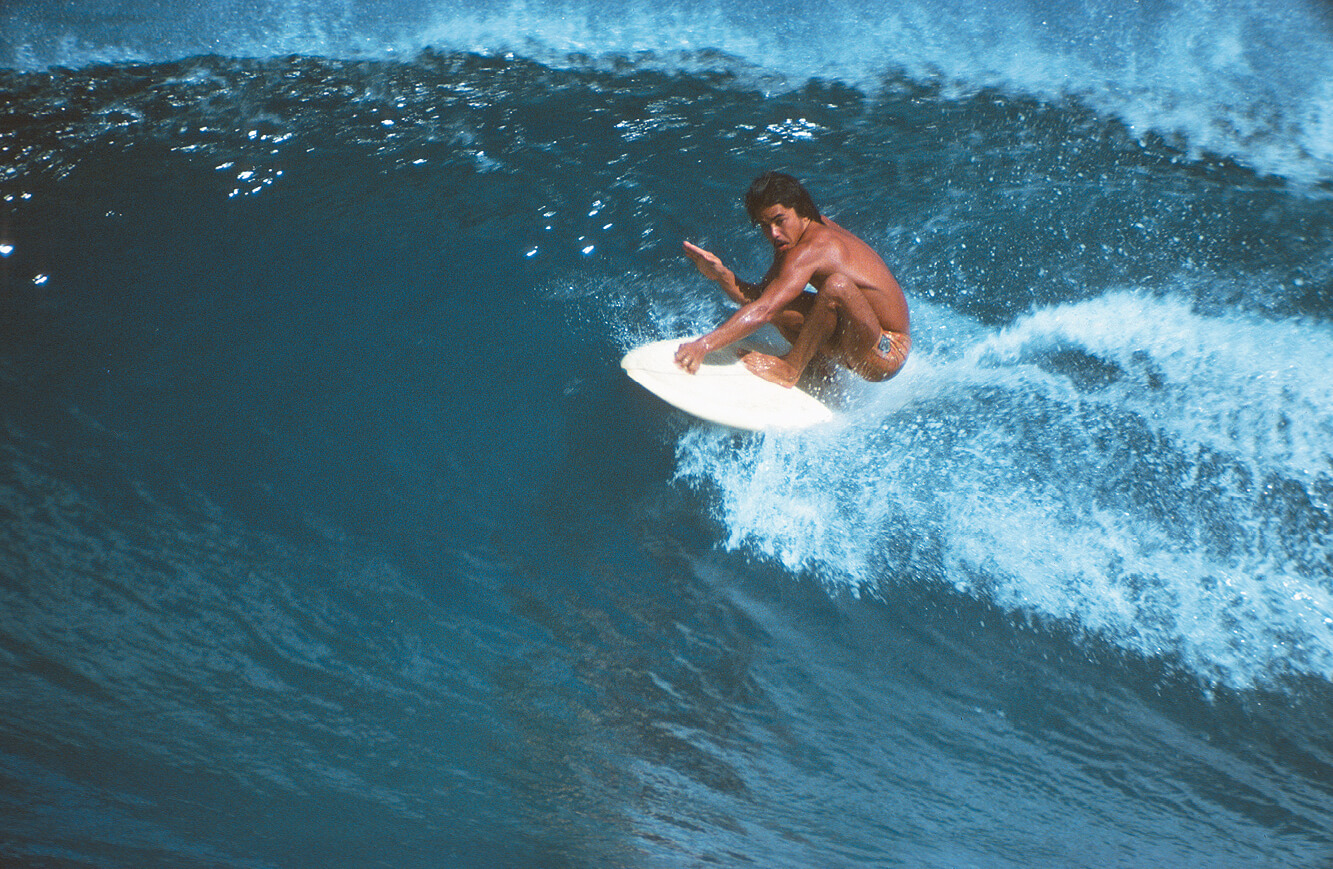The Amazing Stories Of Hawaiian Icon Reno Abellira
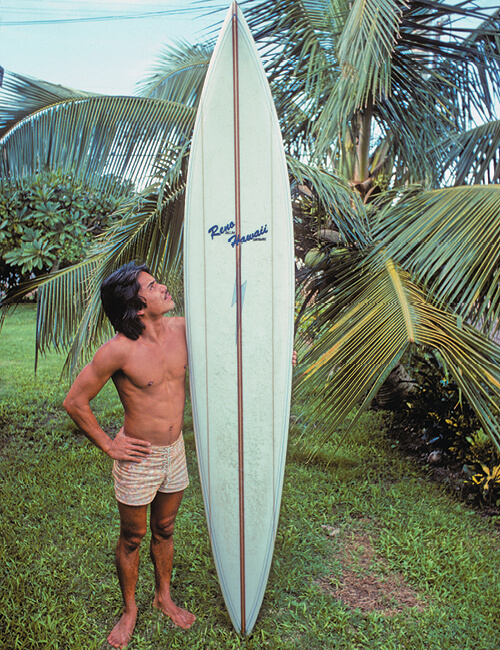
It’s his karaoke go-to, and it’s kind of fitting that Reno Abellira can stand up in a room full of strangers and belt out Purple Rain with all the charisma of Prince himself. The diminutive Hawaiian – much like the diminutive Minnesotan – ran some flamboyant style side-by-side with an enigmatic air. For a Brewer disciple who played a pivotal role in the shortboard revolution, a guy who finished fourth in the world and a guy who won on arguably the biggest contest day ever surfed at Waimea, in some ways Reno has fallen through the cracks of surfing history. In a lot of ways that’s a product of Reno himself. Despite all his achievements and his penchant for flair, he’s preferred to stay in the background and live privately. I tracked him down on the North Shore last winter, and after a series of phone calls and a preliminary meeting he agreed to an interview. We catch up on a rainy Wednesday night at Ruby Tuesday’s in Mililani, Reno waiting, shirt undone to the chest, tiki necklace swinging, looking more 44 than 64. Over an undercooked salmon dinner we talked. Reno’s articulate, a student of Hawaiian history and culture, and on this night, totally animated and fun. Man, I learned a lot. His stories were great, everything from the meeting of the shortboard tribes at Honolua in 1967 to the time he stayed at Cactus for ten weeks, where the locals in the Penong pub mistook him for a teenage aboriginal girl and tried to hit on him.
WAIKIKI. My very first surfing experience was with my uncle, who was a beach boy at Waikiki who’d later become a famous songwriter. I was born in 1950, so it was 1952 when my uncle paddled out with me, and I remember even at that age the sound of the board chattering as it went along. That sound really stuck with me. And then he spun me up on his shoulders and I’m riding the wave and he’s holding me up one-handed, lifting me up in the air flying along.
My dad was a boxer. His bouts would sometimes take him to the mainland but there’d often be a long time between them, so we kinda grew up poor. My dad was killed with a bullet in the back. It was in a pool hall. Upstairs there was a gambling syndicate and my dad having been a boxer was the strong-arm who’d circulate around the tables and make sure no one caused trouble. But the faction he worked for was big, and there were other groups who wanted some of the action and they had to get my father out of the way. They had a contract put out on him, he was murdered and it was never solved. The police never solved it anyway. I had an extended family, which is a fairly common thing in Hawaii. If the parents can’t take care of the kid or the grandparents, there will be aunties or uncles – not related – who will look after you, and the system is called hanai. So Buttons and I kind of experienced that, loosely knit family members, the basic premise being that you always must take care of the kids.
In 1959 George Downing opened his concession on the beach at Waikiki, an A-frame shape, post-modern Polynesian building right on the beach where everyone gravitated. We’d hang at Waikiki there every day and it was like the epicentre of my surfing universe. Down the beach was where everyone started out as a kid riding a rubber mat, a paipo, or if you couldn’t afford a paipo you’d surf a cafeteria food tray like Buttons.
SHORTENING. The very first Dick Brewer board I got to ride was this Brewer Hobie. This thing was 10’2”, a typical gun shape, large squaretail, sleek, must have been 50 pounds. I got to borrow that board and I’m maybe 100 pounds and 5’2” and I rode it and it worked for me. I could ride the nose, I could turn, I could cruise on it. In 1965 some of my other friends like Jock Sutherland and Jeff Hakman, they were riding for Hobie Hawaii and Jeff Hakman had a board I used to borrow/steal from Mrs Sutherland’s house. We’re all coming down to Chuns and that board, an 8’6” Dick Brewer with pink inset foam on the double stringers, was a beautiful board. It was a scaled down version of what Buzzy Trent would ride.
My point here is there were always smaller boards, but they were scaled down versions of the bigger boards and they were pre-empting the shortboard revolution. I didn’t meet Dick till mid-’65. I was 15 years old and he was at that time making boards for Bing, and one of the models that worked in Hawaii was the Bing Pipeliner model. I had three or four of my friends getting the Pipeliner board direct from Dick – Jock Sutherland was riding them, Jimmy Lucas was riding them – and I got one of the last Dick made for Bing. In ’66 I was Hawaii state noseriding champion. RB (Brewer) was on terms with my uncle and he saw potential in me competitively. It was the year after I’d lost my dad, and my uncle was dying of lung cancer, and it was like RB was coming into my life to become my surrogate dad.
In the aftermath of my uncle dying I took my first pro winnings – 600 bucks – and bought a one way ticket to California and stayed with a bunch of Hawaiian guys already living over there. I stayed for the school year, but the important part was I was an alternate on the Hawaiian surf team at the ’66 world contest that Nat Young won. So bang, here comes the death of nose riding and the birth of the shortboard.
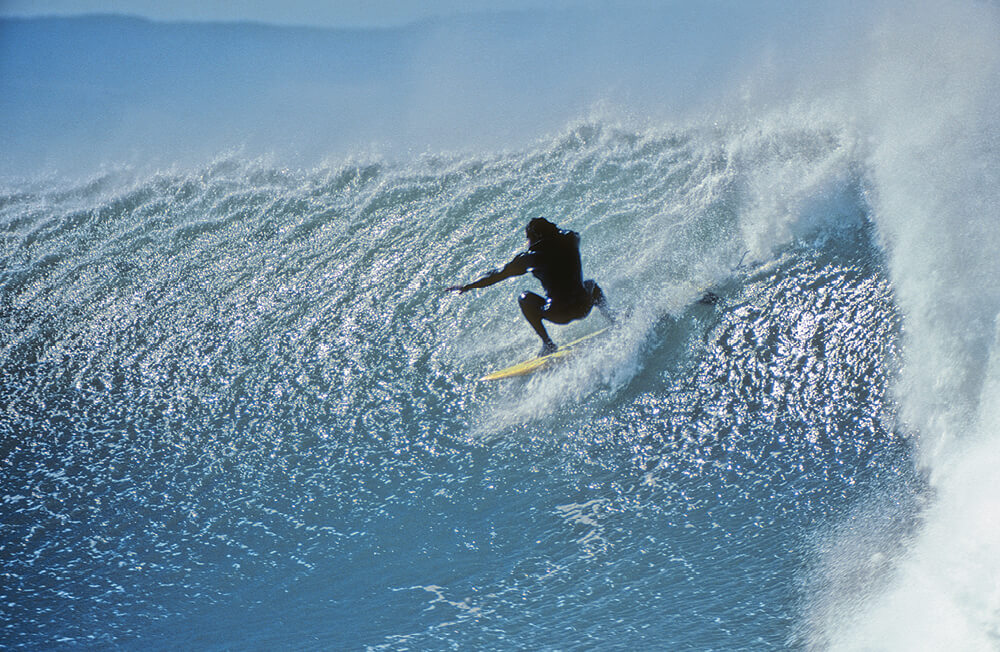
MAUI. I got back to Hawaii in ’67 and by that time Dick wanted me on his surf team and I was telling him I wanted to learn how to shape. Gerry and I became friends that same year. We met and started surfing for Brewer and we apprenticed at the same time, but Gerry was ahead of me on the tools. I took a board that I’d chipped down from a ten-foot balsa malibu that someone had given me in Waikiki, and I shaped it into this teardrop mini-gun. There were issues with the wood – bumblebees had bored through it – and I was killing myself with balsa dust, so I wrapped that thing up in a sleeping bag and went to Maui where Dick Brewer was working and living.
That was the winter McTavish surfed the Duke contest with the Fantastic Plastic, the V-bottom hull boards with the super-wide tails that had been influenced by George Greenough. I remember watching Greenough surf Backyards on this huge day, watching him surf these insane lines, just flying under the lip at 90 miles an hour. At that time we were more concerned about outline and less about length. We were going for the real sleek, streamlined spear of a board with the narrow tail and pulled-in nose. Dick shaped a 9’6” for me, then a 9’9” for Gerry too.
Then McTavish and Nat show up on Maui with their short boards and the first wave Nat catches at Honolua, he takes off and does this bottom turn, the typical into the hook, does it again then fwoom, the board goes sideways, he falls off in the Cave section, and the board goes into the rocks. Nat comes in freaking, and that was the end of the so-called “perfect” session at Honolua. When Nat broke his board, me and RB are down there in the camper with Dick’s wife at the time, and Nat walks over all sheepish cause he wants to get his board repaired and we’re the only people on the island who have resin. We felt they’d come to pillage Honolua, get the shot and get out.
Me and Dick were camped at Honolua and actually the day before this, I was riding my brand new 9’6” and the waves were almost twice as big. I surfed 12-foot Honolua on my brand new board and there were only four of us out and it was perfect, perfect Honolua. My board snapped inside the barrel. There was so much force in there I remember the board compressing like a waffle and just liquefying under my feet.
So McTavish and Brewer got into this two-day argument. “You’re doing it all wrong, you’ve got to have the wide-ass tail!” And Brewer was like, “Nah, that’ll spin out.” It was going back and forth and Dick is saying the mini-gun is the answer. RB says, “I agree we’re pulling down the length but not that shit!” McTavish pulls this blank out and goes, “I’ll show you!” and Brewer goes, “Fine!” In less than an hour McTavish shapes this vee bottom board, 7’11”. I was like, is everyone losing their minds?
When the Aussies split, Brewer’s shaping Gerry’s board and he saws off the tail then redraws it turning a 9’9” into an 8’6”. What Brewer did by chopping off the tail, was that he re-templated the whole board. Gerry was freaking out, almost crying. So Brewer saws the tail then cuts some vee in Gerry’s board, then when he finished he did the same thing with my balsa board. That was an 8’1” and that was my new gun that I brought back to Oahu with me. Gerry had his 8’6” and that was the very first board Gerry ripped on at Pipeline. It all happened on Maui, and the following year Brewer left and moved to Kauai.
“They had to get my father out of the way. They had a contract put out on him, he was murdered and it was never solved.”
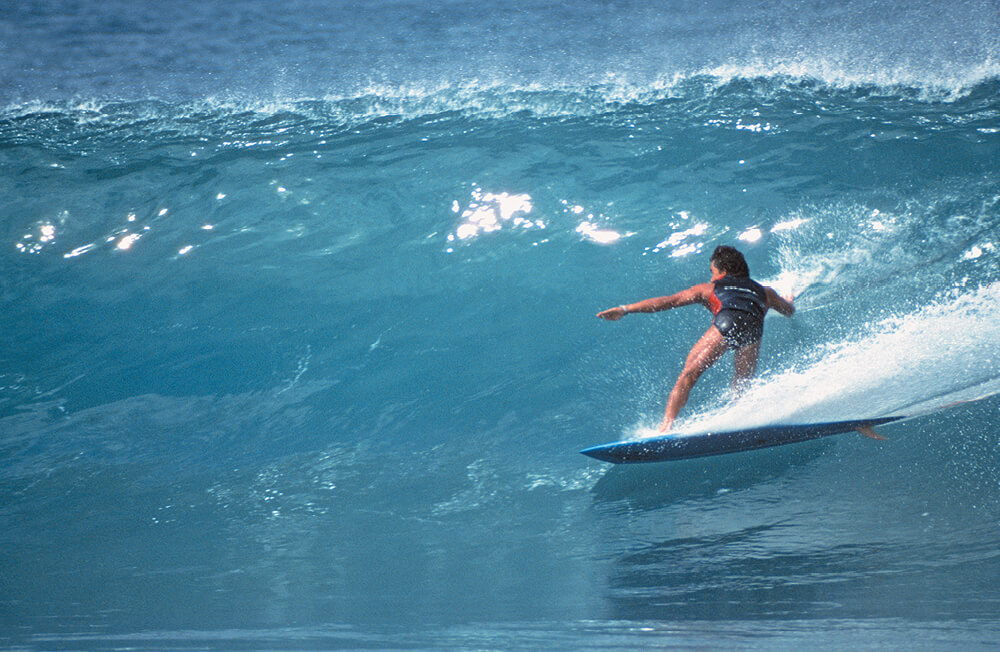
KAUAI. Gerry and I are both there on Kauai in the summertime, apprenticing for Dick Brewer, living with him in Hanapepe. We were surfing Pakalas and a place called Acid Drops. There was nobody around and there was insane surf. In those days you had to walk five miles on the beach into Pakalas ’cause the Robinsons, the owners, they’d take your board and you’d be arrested for trespass if you tried to walk through the village.
So in that summer of ’67, the thing Gerry, Dick and I are trying to get at, the thing was shorter, lighter, and faster. It also meant moulding our bodies to do what our minds wanted us to do. Gerry and I wanted to be the first guys to do the full 360 on the wave, and we were really worried Wayne Lynch was going to be the first guy to do it, because we’d seen pictures of him going straight down, then straight up. The going vertical thing was in our mind, but we wanted to go beyond that and go right around. So Gerry and I were right into yoga, we’d get up at five in the morning to meditate, and Dick was on fire at that stage, all charged up. We were surfing together and eating well, Dick had a new wife and he was happy. My shaping was coming along; it was all happening.
Gerry, myself and Dick started out as the nucleus of the shortboard movement in Hawaii, based around the mini-gun lines being refined. But Gerry early on went his own way. Gerry was good enough to be more than Dick’s apprentice. I was still Dick’s team rider and we developed that board, the flip nose, which came about because Dick Brewer was a former water skier. We both knew speed was utmost and after that we’d figure out the rest, how to turn it. Dick and I were on the same level. We understood each other to the point where we didn’t have to speak much, and I thought he was the best. What we collaborated on was what we wanted to do on a wave. That was our starting point. And it was always, “Why not? If we go too far we can always pull it back.” You’d push to that extreme then pull it back.
“Nat was a vegetarian – the most aggro vegetarian I’ve met.”
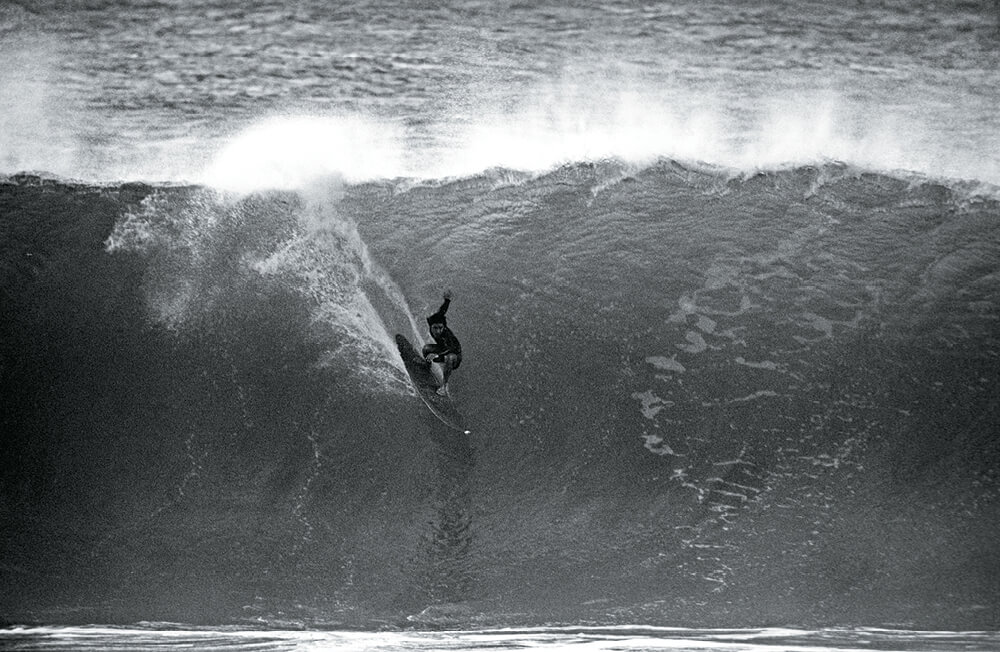
THE SMIRNOFF. I’d have to say winning the Smirnoff at Waimea was the pinnacle of my big-wave surfing career. I’d been a finalist in the Duke a handful of times but I’d never won the Duke, so it was always a regret, competitively speaking, that I didn’t get one.
The night before the Smirnoff I could hear the swell. I was living on the Kam Highway at Backyards, up from Ted’s Bakery and I could hear through the night the surf pounding, the ground shaking. It was a rudimentary surf prediction but I remember someone telling me the surf was still coming up. I’d seen Sunset close out the night before, and it sounded even bigger the next morning. I got a good sleep and woke up early that morning and right at seven I heard this frantic knock on the door, “Reno! Reno! Get up! It’s fucking huge!” It was Jimmy Lucas at my door, freaking out. His eyeballs were out of his head. I’m like, “Okay, okay, cool it down. Let’s have some granola.” He could hardly talk, jumping around in my garage. But that morning everybody was freaking out, and I’d admit if they chose not to run that day I wouldn’t have been upset. But they made the call and we surfed.
Personally, I was really tired of coming in second to Jeff (Hakman). I was waiting for a day when I thought we’d be on neutral ground – not at Sunset – because at that moment in time at a certain size, especially at Sunset, he was almost impossible to beat. At Waimea though I saw a chink in the armour. He just didn’t seem as sure of himself… not that I was completely either, but I felt that with my commitment to the wave there was an opportunity.
Once I was out there the height seemed less important than the volume of water in the wave. The whole heaving action of the wave was intense. I never got a bad take off. On some of the waves I fell it wasn’t near the impact zone, it was closer to the channel, and I’d pop up and my board would be close by so I didn’t have to swim much.
Then about midday when the swell peaked I’d gotten the biggest drop I’d ever had at Waimea. This one wave I got, I got it off José Angel. Peter Cole, Kimo Hollinger and José, they were all out there, didn’t worry that the contest was on. The set comes, I put my head down and paddle for it, but I look to my side and I see José paddling for it. By my fourth stroke I’m yelling, “José? José?” And I remember his deep roar, “Goooooo! Goooooo!” I was blinded by spray, as I got to my feet my board drops out from under me and I felt like I was going over the falls. The board fluttered under me and my feet aren’t there and I’m weightless then finally I get one foot on and I stood up. That was the top of the wave, but I wasn’t near the double-up yet. The bottom fell out of the wave again, and as I drop down it, guess who was paddling up the face? Gerry Lopez. Gerry is paddling up the face on this red and orange board and I can see the fear in his face. His eyes were this big and he just bails the board. I made the drop and it turned into this mountain of white water. It had to be 35 foot. I don’t know what happened to Gerry. I felt like if I’d survived that wave it might be my day.
By the afternoon the waves were evening out a bit, they were less hairy on the take off, and it was breaking end-to-end across the bay. I just sort of stayed consistent for the next two heats and I was announced the winner. I was elated, super fatigued but just on a high. It was Thanksgiving Day and a full moon and we had a turkey dinner that night, so it was pretty epic all around.
BUTTONS. I’m living across the street from V-Land, and at that time there’s a heavy-duty local pack on it, and you couldn’t get a wave without being somebody. Buttons at that stage was living in town and the regular crew were guys like James and Timmy Labrador who grew up just across the road, then there was Perry Dane my neighbour, then was a guy called Wayne Boy Victorino who was one of the first aerialists. Then there’s everybody else who wanted to surf V-Land from the Kailua side or from in town, and that included Buttons, right, but he was always welcome. Michael Ho was out, Johnny Boy Gomes who’s super aggro and Dane Kealoha as well, it was chock a block with guys trying to get in the saddle, and the right place to take off at V-Land is as wide as a phone booth. So we’re all surfing Velzyland and Buttons comes out and the pecking order is tough to work out and the tension out there is palpable, it’s as thick as a glass of stout. There were some gnarly fights. So Buttons shows up and is trying to get his waves, and this day all these heavy guys are out and we’re all sitting in a tight group, all trying to get the next set. I’m sitting next to Buttons when a perfect six-foot set appears and everybody scrambles and in the middle of the group you hear this voice boom, “Go, Buttons! Goooooooooooo!” And everybody looks around and stops and Buttons swings around and goes… and of course it was Buttons calling himself in.
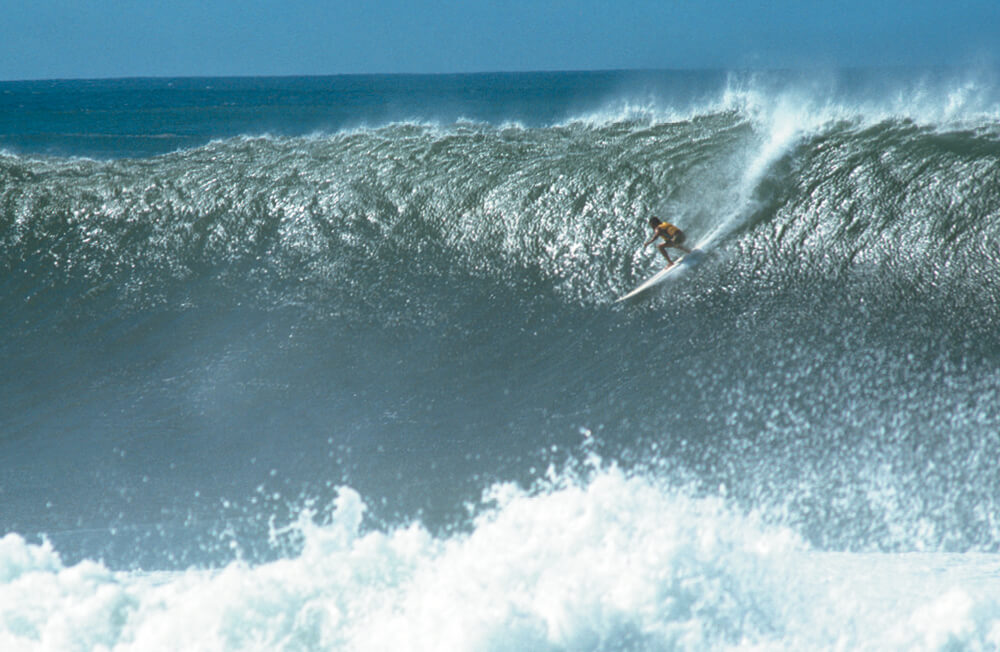
AUSTRALIA. From the World Titles in 1970 in Victoria, I reckon I was in Australia 15 times. They had the Aussie Triple Crown – the Coke, Bells, and the Stubbies or the Alan Oke – that was the Aussie season and it was three months long. I was one of the first guys to fly back home to Hawaii and regroup between each contest. I was one of the few guys who were sponsored, so I’d parse away some money. By 1970s standards I was living the life. It blew a lot of people’s minds though; they thought I was all Hollywood by flying home. It was a long three months. Like, how many beetroot sandwiches and Chiko rolls and meat pies can you eat? Seriously. It was, like, horrible. The food was horrible. But it was also the beginnings of the good diet. The fruit, the veggies, and I noticed a lot of the surfers went that way. That lifestyle was coming into play. Some of my friends in Australia lived well on good food. Nat was a vegetarian – the most aggro vegetarian I’ve met – and we used to joke about that. Isn’t being a vegetarian supposed to mellow you out? But Australia in the ’70s, it was kinda like what California was like in the ’50s, culturally and socially. People were straight up honest, hard working and kind, and I really liked that about Australia.
STYLE. My sense of style probably comes from growing up poor. One comment my mum would make, she’d say, “Just ’cause you kids are poor doesn’t mean you need to look poor.” She impressed on us we should dress well and present well. She was in show business, she was a hula dancer and an entertainer, and as a result I just sort of always appreciated style in dress. I’d watch movies and I’ve always been fascinated by fashion and how much fashion reflects personality. I started going to California early and you had to have some good clothes for a function, you had to climb out of your trunks and your T-shirt some time. Phil Jarratt was one of the first guys to write a profile on me and one of his comments he said, “A lot of people have considered him a bit of a dandy.” (Laughing) Thanks, Phil. But my style ran the whole gamut of the safari suit and platform shoes and the disco shirt, and the big entrance when your plane landed at the airport. When I got to Australia there were some guys who were dressed up but most didn’t give a shit. I felt like coming from a different place, being well dressed and well spoken was important to me. I guess it was part of my persona, a projection that Hawaiians weren’t backwards, and looking sharp made me feel mentally sharp.
The bell-bottom wetsuit was more of an advertising stunt for O’Neill. I promised my friend Pat O’Neill I’d do it. It was obviously about the most flamboyant thing you could go surf with. It was fitted from a high waist and a tight vest and it had this wrestler spandex gusset. It was actually a ski outfit and the bell-bottoms were flared because that’s where the ski boots fitted. It was all cinched up to keep the shape. Of course as soon as I wore it I was cold. I said, well, fuck it, I’ll only do it for 15 minutes. It flushed with water immediately of course but it looked pretty wicked!
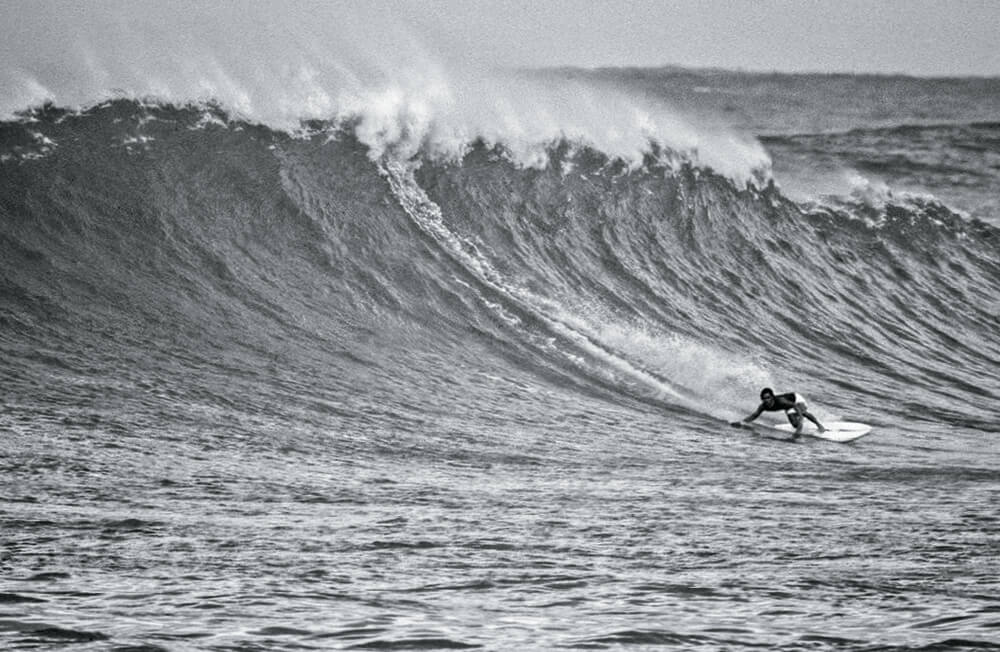
ROLLING HOME. One of the trips I did in Australia was for a movie called Rolling Home with Paul Witzig. This was 1972; I was 22. It was ten young people – including me and my future ex-wife – and we travelled around Australia for it. The basis of the movie was young people leaving the city life to get into the country hinterland and connect with the first peoples. Part of the movie’s mission was to try and relate to aboriginal people on that level.
I got a really good immersion in Australia, because everywhere we went we dropped into the local mission, and while we got good receptions, sometimes we wouldn’t because in some of them there was corruption in the system and some people looked at us with suspicion. The people running them would take government money and set up stores and they’d take the artefacts made by the locals, they had warehouse stashes of the stuff. The people would come and get their money and go walkabout, they wouldn’t even stay in the mission.
We stayed at Cactus, for two-and-a-half months. We built this rough house and we all camped around it. It was so raw. It wasn’t very Hollywood. We had to go into Penong to go get Coopers Ale, water, and to take a bath. We got some waves and luckily never saw any sharks. But it was wild. Every three or four days we’d get blasted. We were in the Great Australian Bight and we’d get all these southerlies blowing through. At the time my hair was down to my shoulders and I kinda looked like a girl. I remember going into this pub in Penong with my wife, and some of the old diggers there are going, “That’s straight up an aboriginal girl!” and my wife was so offended. They were drunk and they honestly thought I was a young aboriginal girl and they were going to have their way with me. My wife lost it. I didn’t have the moustache at this time.
We went everywhere. We followed the coast all the way from Victoria across the desert to Margaret River, then we took a flight to the Northern Territory and the crocodile farms and cashew plantations, then we went to Alice Springs then across to Queensland. By the time we got to Queensland I was over it. With all that desert, once we got to Queensland coast with all that warm water I was never happier.
